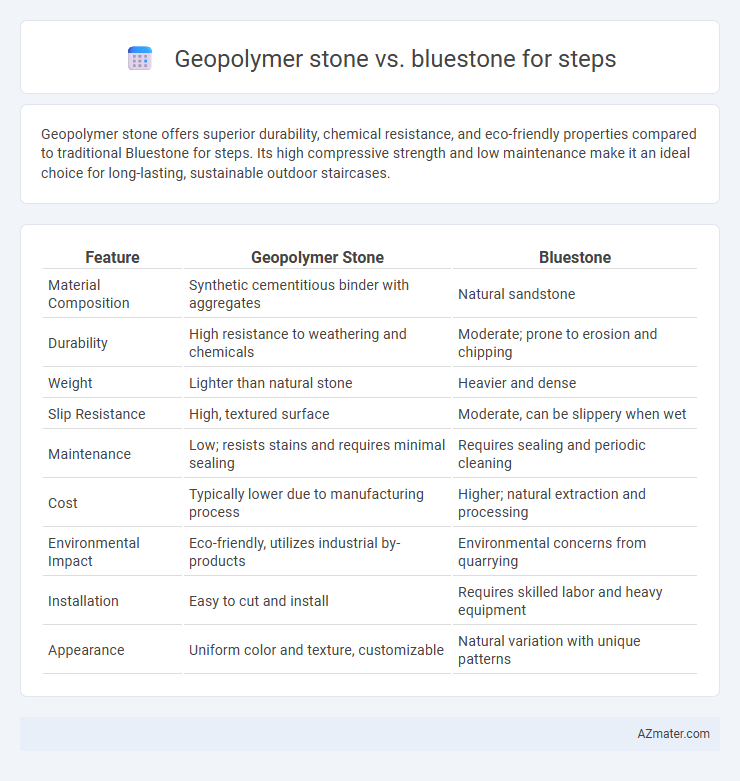Geopolymer stone offers superior durability, chemical resistance, and eco-friendly properties compared to traditional Bluestone for steps. Its high compressive strength and low maintenance make it an ideal choice for long-lasting, sustainable outdoor staircases.
Table of Comparison
| Feature | Geopolymer Stone | Bluestone |
|---|---|---|
| Material Composition | Synthetic cementitious binder with aggregates | Natural sandstone |
| Durability | High resistance to weathering and chemicals | Moderate; prone to erosion and chipping |
| Weight | Lighter than natural stone | Heavier and dense |
| Slip Resistance | High, textured surface | Moderate, can be slippery when wet |
| Maintenance | Low; resists stains and requires minimal sealing | Requires sealing and periodic cleaning |
| Cost | Typically lower due to manufacturing process | Higher; natural extraction and processing |
| Environmental Impact | Eco-friendly, utilizes industrial by-products | Environmental concerns from quarrying |
| Installation | Easy to cut and install | Requires skilled labor and heavy equipment |
| Appearance | Uniform color and texture, customizable | Natural variation with unique patterns |
Introduction to Geopolymer Stone and Bluestone Steps
Geopolymer stone steps offer a sustainable, eco-friendly alternative to traditional materials, featuring high compressive strength and resistance to weathering due to their synthetic inorganic polymer matrix. Bluestone steps, quarried from sandstone, are prized for their natural durability, unique bluish-gray hue, and ability to withstand heavy foot traffic while providing a textured surface for slip resistance. Both materials provide excellent options for outdoor step construction, with geopolymer stone emphasizing engineered performance and bluestone highlighting natural stone aesthetics.
Material Composition and Formation
Geopolymer stone consists of industrial byproducts like fly ash or slag, combined with alkaline activators to form an environmentally friendly, synthetic stone through polymerization. Bluestone is a natural sedimentary rock, primarily composed of feldspar, quartz, and mica, formed over millions of years through geological processes like sediment deposition and lithification. The engineered formation of geopolymer stone allows for tailored strength and durability, while bluestone's natural mineral composition offers unique aesthetics and weathering characteristics.
Durability and Weather Resistance
Geopolymer stone exhibits superior durability and weather resistance compared to bluestone, as its synthetic composition offers enhanced resistance to cracking, chipping, and erosion caused by freeze-thaw cycles and UV exposure. Bluestone, a natural sedimentary rock, is prone to weathering, surface flaking, and color fading over time when subjected to harsh environmental conditions. For outdoor steps in variable climates, geopolymer stone ensures longer-lasting structural integrity and aesthetic appeal, reducing maintenance requirements.
Aesthetic Appeal and Color Variations
Geopolymer stone offers a consistent and customizable color palette, allowing for vibrant and uniform hues that enhance step design with a modern aesthetic. Bluestone presents natural variations in color ranging from deep blues to earthy browns and grays, creating a unique, rustic appeal that changes subtly with weather and wear. The choice between the two depends on whether a controlled, sleek look or organic, dynamic texture is desired for the steps' visual impact.
Installation Process and Complexity
Geopolymer stone offers a streamlined installation process due to its lightweight and uniform composition, simplifying cutting and fitting for steps compared to the denser and more brittle bluestone, which often requires specialized tools and skilled labor. Bluestone's natural variations and hardness increase the complexity of installation, demanding precise handling to avoid cracking or chipping during cutting and placement. Choosing geopolymer stone reduces labor time and installation costs, making it a preferred option for projects prioritizing efficiency without sacrificing durability.
Environmental Impact and Sustainability
Geopolymer stone offers a significantly lower carbon footprint compared to bluestone, utilizing industrial by-products like fly ash and slag, which reduces waste and conserves natural resources. Bluestone extraction involves quarrying natural stone, leading to habitat disruption and energy-intensive processing, whereas geopolymer stone production requires less energy and emits fewer greenhouse gases. Choosing geopolymer stone for steps supports sustainability goals by promoting recycled materials and minimizing environmental degradation.
Cost Comparison and Value for Money
Geopolymer stone offers a cost-effective alternative to Bluestone for steps, typically priced 20-30% lower due to lower material and manufacturing expenses while maintaining comparable durability. Bluestone commands a higher price because of its natural stone composition and extraction costs, but it may provide superior aesthetic appeal and natural variation. For value-conscious projects, geopolymer stone delivers excellent longevity and strength at a reduced upfront cost, making it a practical choice without compromising on performance.
Maintenance Requirements and Longevity
Geopolymer stone requires minimal maintenance due to its high resistance to weathering and chemical damage, making it ideal for outdoor steps. Bluestone, while durable, demands regular sealing and cleaning to prevent staining and surface erosion over time. The longevity of geopolymer stone often exceeds that of bluestone, as it resists cracking and fading in varying environmental conditions.
Slip Resistance and Safety Considerations
Geopolymer stone offers superior slip resistance due to its textured surface and enhanced grip, making it a safer option for steps, especially in wet conditions. Bluestone, while durable and aesthetically pleasing, tends to be smoother and can become slippery when wet, increasing the risk of slips and falls. Safety considerations favor geopolymer stone in areas requiring high traction and minimal maintenance for slip hazards.
Best Applications: Geopolymer Stone vs Bluestone Steps
Geopolymer stone offers superior durability and weather resistance, making it ideal for outdoor steps exposed to harsh climates and heavy foot traffic. Bluestone steps provide a natural aesthetic with excellent slip resistance, perfect for garden pathways and decorative landscaping projects. Choosing between the two depends on prioritizing either long-term strength and low maintenance (geopolymer) or traditional appearance and texture (bluestone).

Infographic: Geopolymer stone vs Bluestone for Step
 azmater.com
azmater.com